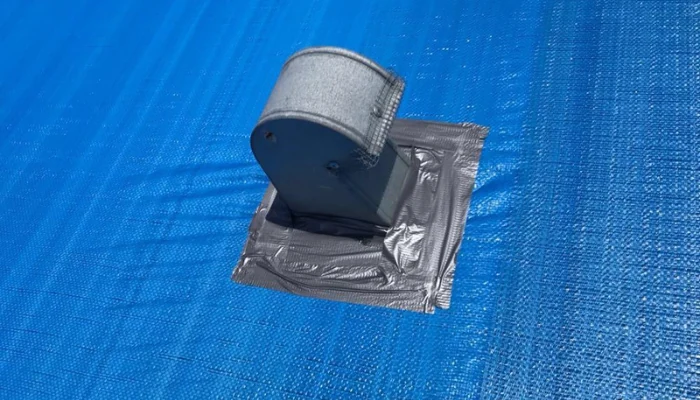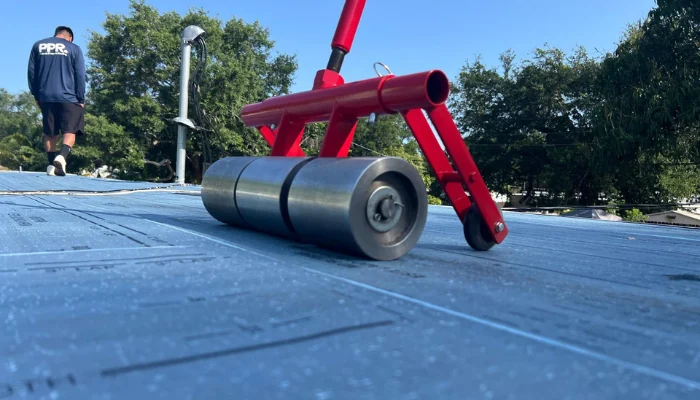Why is China putting blue tarps on their roofs? At first glance, this widespread phenomenon might seem puzzling. However, delving deeper reveals a blend of practical solutions, cultural significance and even some speculative theories.
In regions like Guiyang, residents have adopted blue tin roofs as a cost-effective measure to combat frequent rain-induced leaks; works like an additional protection. Moreover, the color blue holds cultural value in East Asia, symbolizing tranquility and stability. Furthermore, has historical roots in traditional architecture.
Conversely, the rise of conspiracy theories suggests more clandestine reasons for the blue roofs, though these claims lack scientific backing. Understanding the true motivations behind this trend requires a balanced exploration of both the tangible and intangible factors at play.
Today we’ll unravel the layers behind “why is China putting blue tarps on their roofs”, separating fact from fiction and shedding light on the real reasons for this architectural choice.
Understanding the Prevalence of Blue Roofs in China
Have you ever wondered why is China putting blue tarps on their roofs so often? You might see it in a photo, a video, or even while traveling, right? Well, those bright blue covers truly stand out against the landscape.
This happend because, let’s start with the basics, in many parts of China, heavy rain and storms are common. Blue tarps offer a quick and affordable way to protect a house from leaks and further damage. It’s like a raincoat: simple, quick to wear and prevents damage to your clothes.
But there’s more. In some areas, people use these tarps as a temporary fix after a storm while waiting for repairs. In others, they’re part of low-cost housing solutions. According to a report by the China Daily, the use of blue tarps has become so widespread in cities like Guiyang that they’re almost a feature of the skyline.
The color isn’t random either. Blue tarps are easy to spot from above, which can help with government inspections or disaster relief efforts. They’re also cheaper to produce in bulk, which means they’re easier to find in stores and quicker to use in emergencies.
Some folks even see the blue tarps as a sign of resilience, a way to keep a home dry without breaking the bank. After all, not everyone has the cash for a brand-new roof.
However, is it only about the weather or is there something deeper going on? Let’s find out what else these blue roofs might be saying.
Practical Reasons Behind Why is China Putting Blue Tarps on Their Roofs
When it rains, it pours. And when it pours, roofs leak. That’s where the blue tarps come in. In many parts of China, heavy rain is part of life. Homeowners often reach for a blue tarp to save the day – remember, it’s like a rain coat.
One reason blue tarps are so common is the price. A tarp costs a lot less than fixing a roof. Plus, the work can be done quickly, which helps keep things dry until proper repairs can be made.
Another factor? Blue tarps are tough. They’re made to handle the wind and rain. They’re easy to install and just as easy to remove what is key in places where storms come and go without warning. Instead of waiting weeks for a professional, families use blue tarps to protect what they have.
And let’s not forget about the pitch of the roof. Some roofs are so steep that sandbags can’t hold the tarp in place. In those rare cases, you might see nails or screws, but only when there’s no other choice. Usually, it’s safer to avoid hammering anything down because that can cause more damage.
So, if you’re scratching your head about those blue tarps, remember this: they’re not just a band-aid. They’re a smart, fast and cost-effective way to keep a home safe when the weather turns wild.
Cultural and Historical Significance of Blue in Chinese Architecture

It’s no secret that colors matter a lot in Chinese culture. The blue color in particular it’s more than just a bright pop on a roof.
Blue has long been seen as a symbol of calm and stability in China. In traditional architecture, blue tiles and designs can be found on temples and historic buildings. They’re meant to bring a sense of peace and balance.
Think back to ancient times when emperors built their temples. Blue was used to honor the sky and the heavens. It stood for hope and renewal. Fast forward to today, you’ll still see bits of that history in the choice of blue tarps.
There’s also a practical side to this color choice. Blue is easy to spot from above, whether by a drone or a helicopter, which makes it easy for rescuers to work in emergency situations during floods or storms. And some people even say that the color blue brings luck in hard times.
For homeowners and families, that cultural connection adds another layer to the choice. Sure, blue tarps are cheap and easy to find. But they also feel familiar. While it might seem like blue tarps are all about cost and quick fixes, there’s a deeper meaning woven in: the tradition, the calm and the peace.
The Emergence of the ‘Blue Roof’ Conspiracy Theories
Let’s be honest, some folks just can’t resist a good mystery. So, when they saw blue tarps popping up all over China, a few wild stories took root. It’s not a case of “why is China putting blue tarps on their roofs”, but an opportunity to create a crazy story.
One of the biggest? That these blue tarps somehow shield buildings from satellites or military tech. It’s the kind of idea that belongs only in a movie, not real life. There’s no proof of any “special powers” in those bright blue covers.
Another story making the rounds claimed that blue tarps are used to hide secret government buildings. Again, zero proof. These tarps are usually thrown up in a hurry after a storm, not as part of some secret plan to dominate people or the world.
Experts in architecture and urban planning have weighed in. They say the real reason is simple: weather protection. In fact, a report from the Global Alliance for Buildings and Construction confirms that blue tarps are a cheap and quick fix for water damage.
But let’s face it: conspiracy theories spread fast, especially online. They’re fun to share at parties. However, if you’re looking for facts, here’s the bottom line: blue tarps are about keeping homes dry and safe, not hiding government secrets.
So next time you hear someone mention a “blue roof conspiracy,” you’ll know it’s all just talk. The real story is far less dramatic and just a practical choice in a country that sees a lot of rain.
Debunking Myths on Why is China Putting Blue Tarp on Theis Roofs
Alright, let’s cut through the noise. Scientists and engineers have looked at these blue tarps with clear eyes and the verdict is in. Blue tarps aren’t magic, neither part of any grand scheme. They’re just good old-fashioned weather protection.
Like we said before, blue tarps are used because they’re affordable and easy to find. That’s it. They don’t block signals and don’t hide anything. They keep out water and they hold up to rough weather.
Roofing professionals point out something important: blue tarps stand out in satellite images and aerial inspections. That’s handy during storm relief efforts, but it doesn’t mean there’s anything shady going on.
So if you’re picturing some sort of James Bond – even Argylle now – cover-up, you can let that go. They’re only fiction, the truth is a lot more down-to-earth. Blue tarps are a quick fix, not a fancy gadget. It’s a “help thing” for homeowners ride out the storm… literally.
And that’s what really matters. It’s not about secrets.
Comparative Analysis: Blue Roofs in Other Countries

Here’s a clean and direct comparative table that highlights why is China putting blue tarps on their roofs and the reason in other countries, following your guidelines for clarity and precision:
| Country | Main Use of Blue Tarps | Common Reason for Use | Typical Approach to Installation |
|---|---|---|---|
| China | Cover roofs quickly after heavy rain or storms | Cost-effective fix and easy to get | Mostly uses sandbags; nails only in rare cases |
| United States | Temporary roof cover after hurricanes or storms | Fast protection to prevent further damage | Often uses sandbags or weighted materials; nails used but not advised |
| Japan | Quick cover after earthquakes or typhoons | Protects from rain while waiting for repairs | Similar to China: sandbags or ropes; nails rarely used |
When and Why to Consider Blue Tarp Installation
Let’s keep it real, sometimes a blue tarp is your best friend. If a storm just rolled through and your roof is leaking like a faucet, don’t wait. Slap on a blue tarp because it’s quick, cheaper than a roof replacement and it keeps your stuff dry.
Blue tarps are also handy if you’re waiting for insurance paperwork or a contractor’s schedule to clear up. They buy you time without breaking the bank. In fact, prices usually range from $800 to $1,600+ – in Florida -, depending on your roof’s pitch, size and damage. That’s a lot easier on the wallet than redoing a whole roof.
Quick and easy step-by-step
Getting that tarp up isn’t rocket science, but you’ve got to do it right, especially if you want to keep the insurance folks happy and avoid bigger headaches down the road.
- Step 1: Inspect the roof – Look for damage. Don’t just slap a tarp on top of everything. Know what you’re dealing with.
- Step 2: Choose the right tarp – Go for a heavy-duty, waterproof tarp that covers all the damaged spots.
- Step 3: Secure with sandbags or ropes – Forget the nails and screws – unless your roof pitch is so steep sandbags won’t cut it. Hammering things in can lead to more problems (and might void your insurance claim).
- Step 4: Double-check the coverage – Make sure that tarp covers the damage completely. No one likes water dripping down the living room wall.
- Step 5: Inspect regularly – Give it a look every few days. If the wind’s been howling or there’s been a lot of rain, it might need a little adjustment.
Maintenance tips
Blue tarps aren’t forever, but you can help them stick around a bit longer.
- Clean up debris: Branches, leaves, and other junk can wear out the tarp. Keep it clean and clear.
- Check for tears: If you see a rip, patch it right away. Small holes can turn into big headaches fast.
- Secure it tight: Loose tarps flap in the wind and wear out faster. Keep those sandbags in place and adjust as needed.
- Watch the weather: If you know a storm’s coming, give the tarp a once-over. Better to find a weak spot before the wind does.
Little reminder: Protect Preserve Roofing has the know-how and the crew to get your roof covered and keep it that way. Reach out to us today and we’ll take care of the rest.
Conclusion: Protect Preserve Roofing – Expertise in Blue Tarp Installation
When it comes to blue tarps, there’s no need to play a guessing game. Protect Preserve Roofing knows the drill. We’ve seen it all: storm damage, leaky roofs and homeowners scrambling to cover the mess. That’s why our team steps in with experience and a steady hand.
We understand that a tarp isn’t just a quick fix. It’s about protecting what matters most. That’s why we work fast and get it right the first time. Our crew uses the right gear and the best methods. No risky nails or shortcuts that make problems worse. We know how to secure a tarp with care so it keeps you dry and doesn’t wreck your insurance claim.
And let’s be real, money matters. We’re upfront about costs with prices typically ranging – depending on your roof’s pitch, height, and how much damage you’re dealing with. You can even get a quick estimate just click here.
Thousands of homeowners trust Protect Preserve Roofing because we get it done with honest work. If you’re staring at a leaky ceiling or a storm-worn roof, give us a call, let us help you keep things safe and dry.









